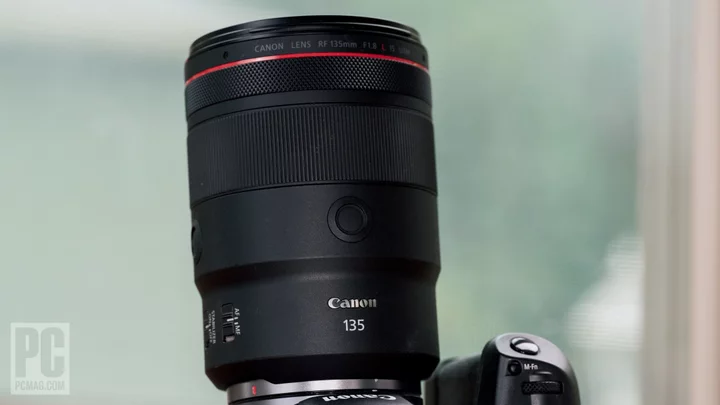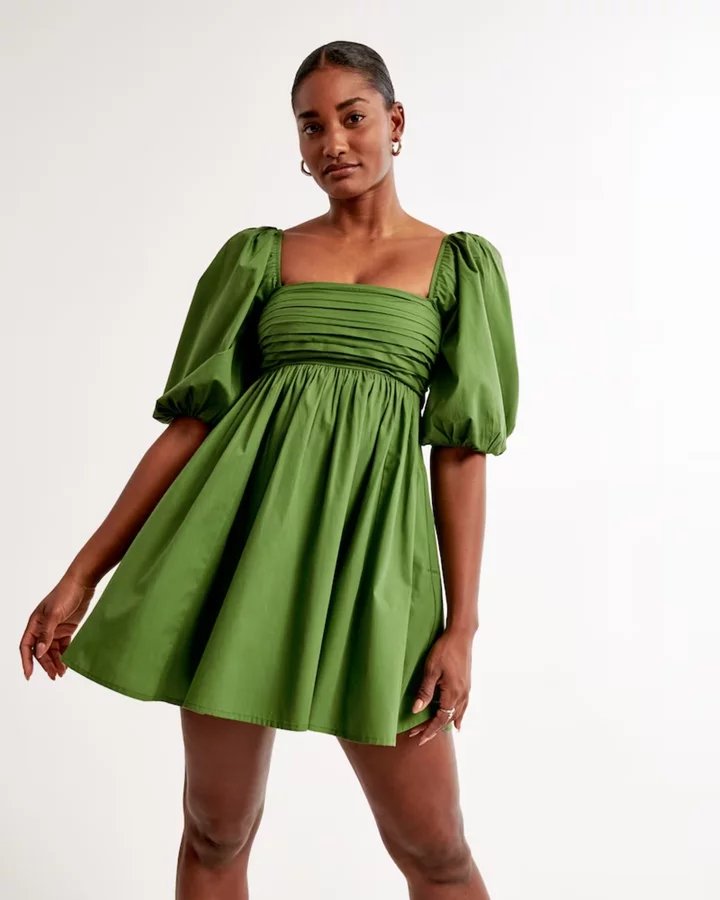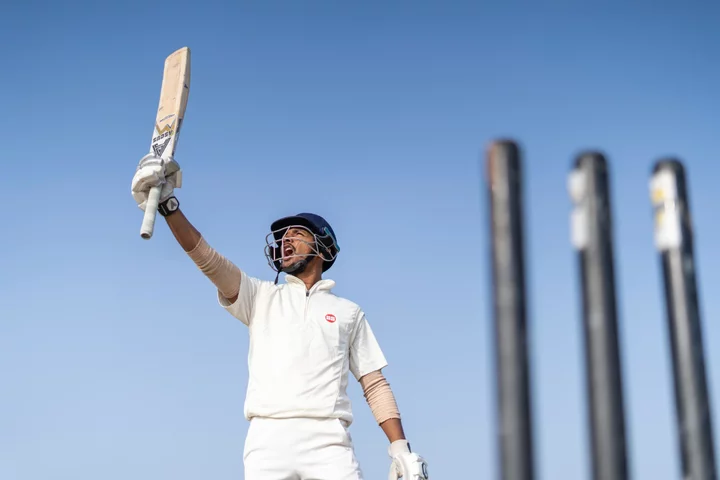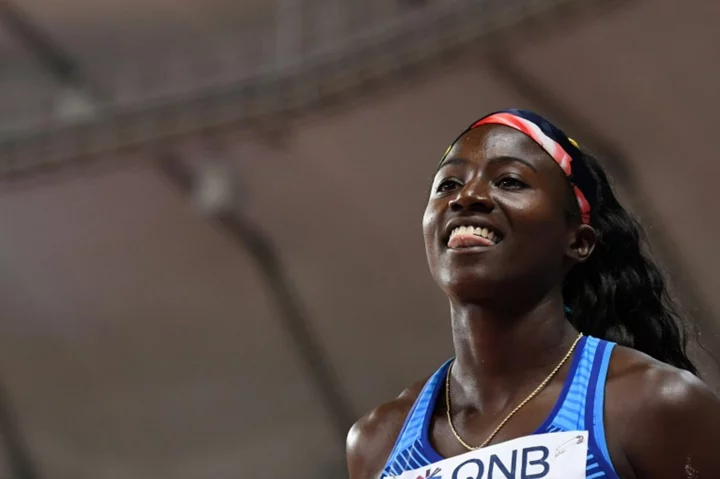The Canon RF 135mm F1.8 L IS USM ($2,099) is easy to pigeonhole as a portrait specialist because its low f-stop and moderately long focal length help it draw soft backgrounds, but its snappy focus motor makes the lens just as appropriate for sports and candids. Other highlights include crisp image quality, full weather protection, and the ability to focus close for decent macros. Given all those positives (and despite some focus breathing), the 135mm undoubtedly deserves our Editors' Choice award, especially since it costs far less than either edition of the RF 85mm F1.2 L USM (starting at $2,699).
Not Too Much to Carry
The RF 135mm's focal length falls smack in the middle of what a typical pro zoom like the RF 70-200mm F2.8 L IS USM sees. At 5.1 by 3.5 inches (HD) and 2.1 pounds, it's on the large side for a prime, but not oversized. Sony's $1,900 FE 135mm F1.8 GM (5.0 by 3.5 inches, 2.1 pounds) and Nikon's $2,499.95 Plena 135mm F1.8 (3.9 by 5.5 inches, 2.2 pounds) are similar in dimensions, but the 2.6-pound RF 85mm F1.2 L is heavier.
(Credit: Jim Fisher)Construction is typical for an L series lens. The 135mm's polycarbonate barrel is sturdy and weather-sealed, while the front glass has an anti-smudge fluorine coating. You can add an 82mm filter for protection or creative reasons, though the included hood keeps the front element away from danger pretty well already. Canon includes both front and rear caps, as well as a soft drawstring pouch with the lens.
RF system owners have a few other lenses to consider in this mid-telephoto range. The RF 85mm F1.2 L USM, for example, is available in two versions. The basic edition is a standard bright prime for shallow-depth-of-field and low-light imaging, whereas the fancier Defocus Smoothing (DS) iteration adds an apodization filter for more buttery backgrounds at the expense of some light loss. As for zooms, the RF 70-200mm F2.8 and 70-200mm F4 are the most sensible alternatives; neither has a prime-level f-stop but both still blur backgrounds and offer a more versatile focal range.
EOS R5, f/1.8, 1/200-second, ISO 250 (Credit: Jim Fisher)Quality Controls and Quick Focus
Canon outfits the RF 135mm with a few on-barrel function buttons and switches, but it's hardly oversaturated. A control ring sits toward the front of the lens, while a manual focus ring slots in prominently behind it mid-barrel. A pair of function buttons behind the focus control drive or lock focus (depending on your camera settings). Additional switches swap focus modes and toggle image stabilization.
(Credit: Jim Fisher)Like with many premium Canon lenses, you can customize the control ring's function. I use it for EV compensation, but you can also configure it to change the ISO, aperture, shutter, or white balance, as well as many other less common settings via your camera's menu. The ring's detent clicks make it easy to dial in adjustments at regular increments, but Canon can change it to a silent control ring for an $80 fee if you prefer that operation style for cinema work. This is a far less convenient process than for Sony system lenses, which typically let you swap the click behavior via a simple toggle switch. Still, it's better than no option at all.
(Credit: Jim Fisher)A linear motor handles focus duties for the RF 135mm. The lens responds quickly overall, snapping from close to distant subjects in a split-second on the EOS R5. The combination of its snappy focus response, bright aperture, and moderately long focal length makes the lens a fine choice for covering indoor sports, such as basketball. I just wish Canon had included a focus limiter since the lens can slow a little if it tries to focus at near distances.
EOS R5, f/1.8, 1/1,600-second, ISO 100 (Credit: Jim Fisher)Breathing is an issue for video. The 135mm's angle of view shifts noticeably along with focus, so it's not a good choice for rack focus shots. The bloom in angle has a benefit though: Because the lens has a narrower view close up, it can get 1:3.8 macros at its nearest 27.6-inch focus distance. This makes it more versatile than the RF 85mm F1.2 (1:8.3), but don't count out the affordable RF 85mm F2 Macro IS STM ($599.99) if you want to get even closer.
Most Canon cameras, and almost all the ones pros use, include in-body image stabilization, a feature that's most effective for wide-angle lenses. But putting IS into the optics like Canon does here ensures that you see a stable image when you compose photos in the viewfinder. I managed consistently blur-free handheld photos at 1/30-second with IS enabled on the R5 and got as far as 1/4-second with hit-or-miss results. Even at 1/30-second, subject motion is a concern for portrait work, so this lens gives you the freedom to work handheld.
EOS R5, f/1.8, 1/160-second, ISO 200 (Credit: Jim Fisher)RF 135mm F1.8: In the Lab
I mostly used the RF 135mm with the 45MP EOS R5 for testing in the real world but also tried it with the 24MP EOS R6 Mark II. For lab tests, I opted for the higher-pixel camera. Unsurprisingly, the RF 135mm is phenomenally sharp because its focal length lends itself to particularly high-contrast optical formulas. The 135mm scores in the excellent range in Imatest (4,200-4,400 lines) from f/1.8-4, and is outstanding (4,600 lines) at f/5.6-8. Photos are crisp from center to edge.
EOS R5, f/1.8, 1/200-second, ISO 200 (Credit: Jim Fisher)Diffraction sets in and starts to affect picture quality at f/11, though results are still very sharp. Pictures are softer at f/16-22, but you might still want to set the aperture to these settings to get sunstars. The 135mm F1.8 isn't a typical pick for landscape work, but it still draws crisp, 18-point starbursts at the narrowest apertures if you ever want to try for that effect.
EOS R5, f/1.8, 1/2,500-second, ISO 100 (Credit: Jim Fisher)Background defocus at wider apertures is a more pressing concern. At f/1.8 (or close to it), the lens blurs backgrounds readily and expertly. I couldn't spot any false color (LoCa) in areas of focus transitions or any distracting texture or onion skin effect in the bokeh. Defocused highlights are pleasingly round in the central area of the frame, but take on a cat's eye shape toward the edges at f/1.8-2. Ratcheting down to f/2.8-4 gets circular highlights across the frame. This is similar in handling as Sony's 135mm F1.8 GM, though Nikon does things differently with its Plena 135mm; we've not tested it yet, but early sample photos show it's capable of rounded bokeh across the frame wide-open.
EOS R5, f/1.8, 1/640-second, ISO 100 (Credit: Jim Fisher)Lateral chromatic aberration, which usually appears as purple fringing around power lines and tree branches, isn't a concern either. Likewise, the lens shows just a little bit of pincushion distortion. In-camera and Raw correction profiles compensate for it, but you'd be hard-pressed to spot an uncorrected photo outside of an architectural study or similarly technical exposure. If left uncorrected, the lens casts a vignette at wider f-stops, but it's also slight enough for in-camera correction to handle effectively. Creators who work in a Raw format might apply a profile or tune it to taste since adding a bit of a vignette during the editing process often improves a portrait.
EOS R6 Mark II, f/1.8, 1/8,000-second, ISO 100 (Credit: Jim Fisher)Ideal for Bokeh Portraits (and More)
Although 135mm prime lenses are intrinsically suitable for portraiture given their telephoto compression and typically bright aperture that melts backgrounds into nothing, the RF 135mm F1.8 L IS USM still impresses with superb sharpness, effective stabilization, and durable construction. Even its somewhat premium $2,099 price is in line with competitors, and far less than what Canon charges for the RF 85mm F1.2 L IS USM ($2,799). Bokeh fiends might choose the 85mm F1.2 DS ($3,099) because of its apodization filter, but the RF 135mm is much more versatile for everyone else thanks to its lighter build and macro abilities, so it earns our Editors' Choice award.









